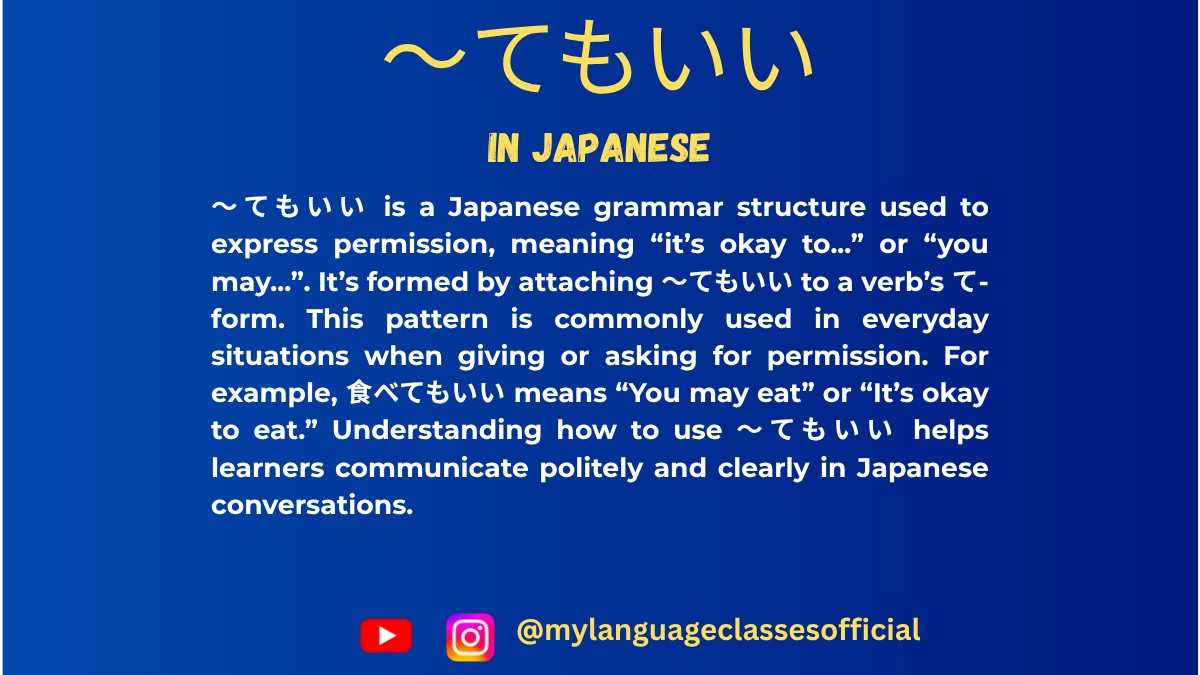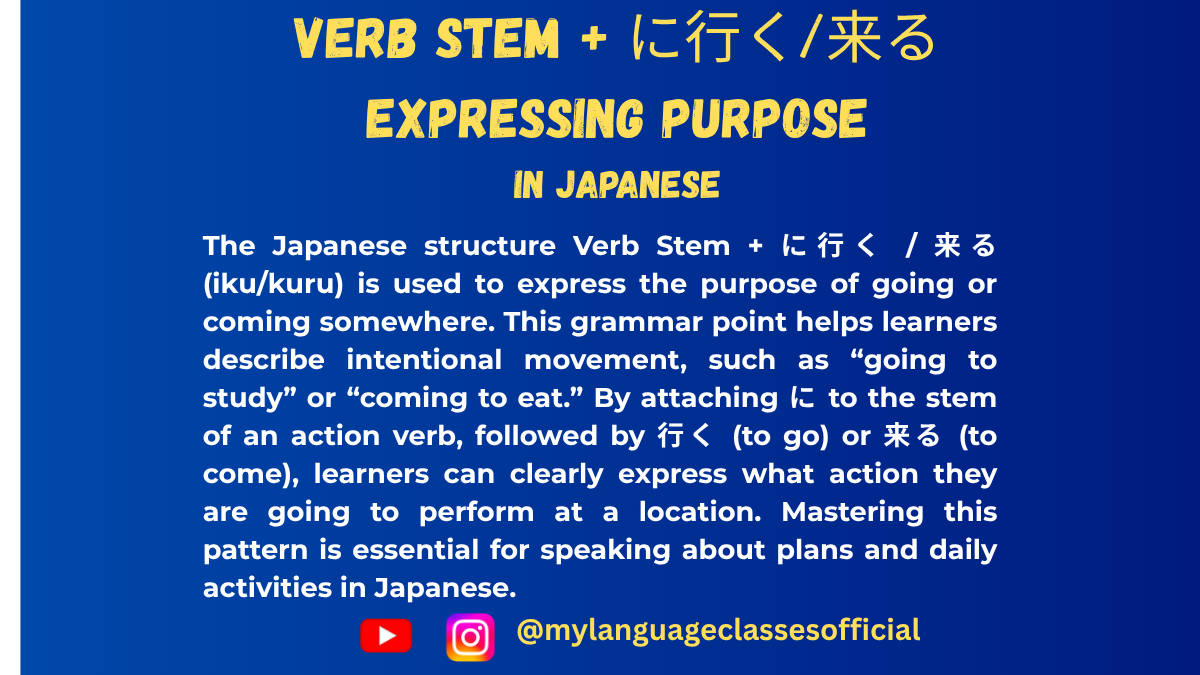Your cart is currently empty!
Tag: Learn Japanese Online
-

Understanding “〜てはいけない” in Japanese | My Language Classes
How to Use 〜てはいけない
The phrase “〜てはいけない” is a common Japanese grammatical structure used to express prohibition, or things that are not allowed. It translates to “must not” or “cannot” in English. This phrase is widely used in various contexts, from giving instructions to setting rules.
Formation of 〜てはいけない
The structure “〜てはいけない” is formed by attaching て-form of a verb to はいけない. Here’s how it works:
- Convert the verb to its て-form.
- Add はいけない to the end of the verb.
Example:
- 食べる (to eat) → 食べてはいけない (must not eat)
- 行く (to go) → 行ってはいけない (must not go)
Situations Where “〜てはいけない” is Used
- Rules and Regulations
Used to express prohibitions in formal and informal rules:- 学校で携帯電話を使ってはいけない。
(You must not use mobile phones at school.) - ここでタバコを吸ってはいけません。
(You must not smoke here.)
- 学校で携帯電話を使ってはいけない。
- Giving Orders or Instructions
Often used in scenarios where instructions need to be clear:- 試験中に話してはいけない。
(You must not talk during the exam.) - このドアを開けてはいけません。
(You must not open this door.)
- 試験中に話してはいけない。
- Moral or Ethical Prohibitions
Refers to socially unacceptable behaviors:- 他人のものを勝手に使ってはいけない。
(You must not use someone else’s belongings without permission.) - 嘘をついてはいけません。
(You must not lie.)
- 他人のものを勝手に使ってはいけない。
- Safety Warnings
Used to highlight actions that could lead to danger:- この薬を飲んでお酒を飲んではいけません。
(You must not drink alcohol after taking this medicine.) - 火のそばで遊んではいけない。
(You must not play near fire.)
- この薬を飲んでお酒を飲んではいけません。
- Expressing Social Norms
Indicates socially expected behaviors or taboos:- ご飯を食べながらしゃべってはいけません。
(You must not talk while eating.)
- ご飯を食べながらしゃべってはいけません。
- Parent-Child or Teacher-Student Scenarios
Frequently used in educational or authoritative contexts:- 遅くまでテレビを見てはいけない。
(You must not watch TV until late.) - 宿題を忘れてはいけません。
(You must not forget your homework.)
- 遅くまでテレビを見てはいけない。
Points to Remember
- Polite Variations
In formal or polite speech, いけない can be replaced with いけません:- ここに入ってはいけません。
(You must not enter here.)
- ここに入ってはいけません。
- Casual Variations
In casual speech, てはいけない may become ちゃいけない or じゃいけない:- そんなことしちゃいけないよ!
(You shouldn’t do that!)
- そんなことしちゃいけないよ!
- Cultural Context
Understanding when to use “〜てはいけない” depends on the context. Japanese culture often emphasizes politeness and indirectness. Therefore, use polite forms in formal settings to avoid sounding harsh.
Examples of Verbs and Usage
Verb (Dictionary Form) て-Form Usage Example 飲む (to drink) 飲んで お酒を飲んではいけない。(You must not drink alcohol.) 遊ぶ (to play) 遊んで 道路で遊んではいけない。(You must not play on the road.) 書く (to write) 書いて 壁に書いてはいけません。(You must not write on the wall.) 行く (to go) 行って 危険な場所に行ってはいけない。(You must not go to dangerous places.) 話す (to talk) 話して 授業中に話してはいけません。(You must not talk during class.)
List of Situations for “〜てはいけない”
- At school (e.g., no phones, no talking during tests)
- At work (e.g., no eating at desks, no accessing unauthorized files)
- Public spaces (e.g., no littering, no smoking in non-smoking zones)
- During social interactions (e.g., no interrupting others, no offensive comments)
- While driving (e.g., no using phones, no speeding)
- At home (e.g., no playing with dangerous tools, no staying up too late)
- With safety rules (e.g., no entering restricted areas, no consuming certain substances)
By understanding and mastering the use of “〜てはいけない,” you can effectively communicate prohibitions and rules in Japanese. This structure is crucial for clear, polite, and culturally appropriate expressions in both written and spoken Japanese.
If you enjoyed this lesson, be sure to check out more posts like this on my blog at My Language Classes. Don’t forget to subscribe my YouTube channel and follow me on Instagram for the latest language learning tips and lessons. Leave a comment below to share your thoughts, or ask any questions you have about nouns.
Happy learning! 😊
-
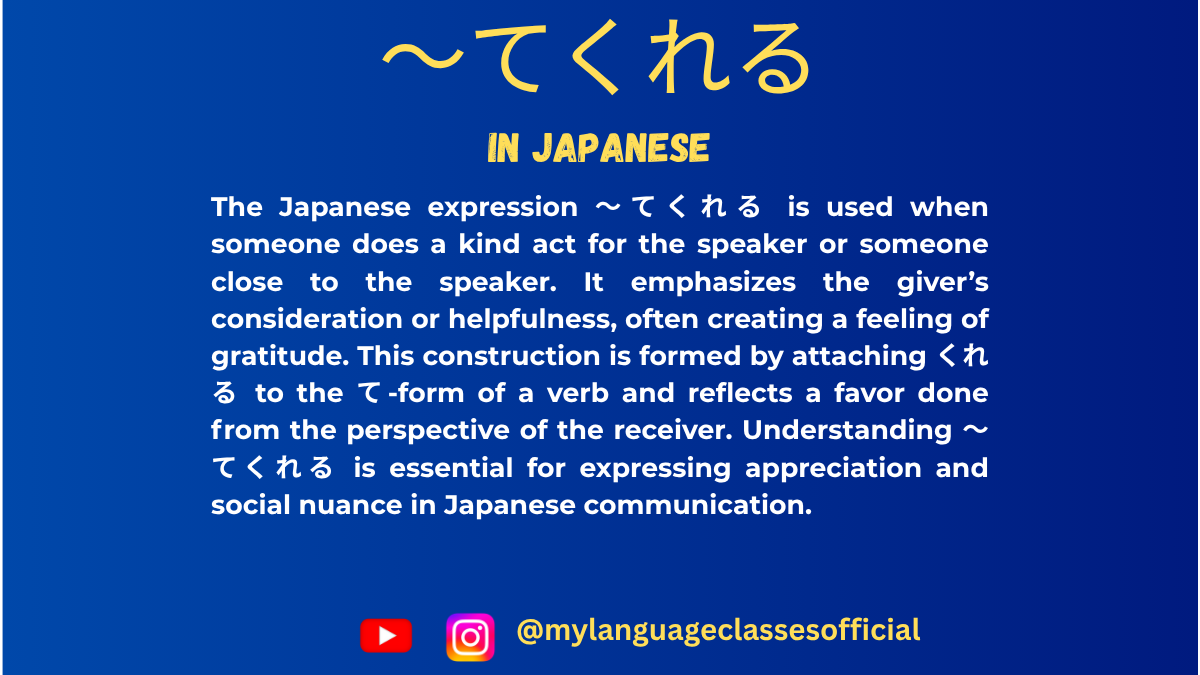
How to Use 〜てくれる | My Language Classes
Understanding “〜てくれる” in Japanese
The Japanese expression 〜てくれる is a key grammatical structure used to describe actions done for the speaker’s benefit or someone close to them. It conveys gratitude and appreciation towards the doer. Let’s explore its usage in various contexts and provide a list of situations where “〜てくれる” is used.
What is 〜てくれる?
“〜てくれる” is derived from the verb くれる, which means “to give.” When attached to the て-form of a verb, it expresses that someone performs an action for the speaker (or someone in the speaker’s inner circle). It implies a sense of appreciation and goodwill.
- Structure:
[Person] が [Verb (て-form)] くれる
(Someone does something for me or someone in my group.) - Example:
- 友達が宿題を手伝ってくれた。
(Tomodachi ga shukudai o tetsudatte kureta.)
→ “My friend helped me with my homework.” - 先生が日本語を教えてくれました。
(Sensei ga Nihongo o oshiete kuremashita.)
→ “The teacher kindly taught me Japanese.”
- 友達が宿題を手伝ってくれた。
Situations Where 〜てくれる is Used
1. When Someone Helps You
Used when someone provides assistance that benefits the speaker.
- Example:
- 兄が荷物を運んでくれた。 (Ani ga nimotsu o hakonde kureta.)
→ “My older brother carried my luggage for me.”
- 兄が荷物を運んでくれた。 (Ani ga nimotsu o hakonde kureta.)
2. When Someone Gives You Something
Used when someone gives you an object (related to くれる itself).
- Example:
- 友達がプレゼントを買ってくれた。 (Tomodachi ga purezento o katte kureta.)
→ “My friend bought me a present.”
- 友達がプレゼントを買ってくれた。 (Tomodachi ga purezento o katte kureta.)
3. When Someone Does a Favor for You
Used when someone voluntarily does something kind.
- Example:
- 彼が傘を貸してくれた。 (Kare ga kasa o kashite kureta.)
→ “He lent me an umbrella.”
- 彼が傘を貸してくれた。 (Kare ga kasa o kashite kureta.)
4. When Someone Teaches or Instructs You
Used when someone imparts knowledge or skills.
- Example:
- 先生が漢字の書き方を教えてくれた。 (Sensei ga kanji no kakikata o oshiete kureta.)
→ “The teacher taught me how to write kanji.”
- 先生が漢字の書き方を教えてくれた。 (Sensei ga kanji no kakikata o oshiete kureta.)
5. When Someone Listens to You
Used when someone listens or gives attention to you.
- Example:
- 友達が悩みを聞いてくれた。 (Tomodachi ga nayami o kiite kureta.)
→ “My friend listened to my worries.”
- 友達が悩みを聞いてくれた。 (Tomodachi ga nayami o kiite kureta.)
6. When Someone Accompanies You
Used when someone goes with you somewhere.
- Example:
- 母が病院まで一緒に行ってくれた。 (Haha ga byouin made issho ni itte kureta.)
→ “My mother went to the hospital with me.”
- 母が病院まで一緒に行ってくれた。 (Haha ga byouin made issho ni itte kureta.)
7. When Someone Encourages or Supports You
Used when someone gives encouragement.
- Example:
- 彼が試験の前に励ましてくれた。 (Kare ga shiken no mae ni hagemashite kureta.)
→ “He encouraged me before the exam.”
- 彼が試験の前に励ましてくれた。 (Kare ga shiken no mae ni hagemashite kureta.)
8. When Someone Waits for You
Used when someone waits patiently for you.
- Example:
- 友達が駅で待ってくれた。 (Tomodachi ga eki de matte kureta.)
→ “My friend waited for me at the station.”
- 友達が駅で待ってくれた。 (Tomodachi ga eki de matte kureta.)
9. When Someone Fixes or Repairs Something for You
Used when someone fixes something for your benefit.
- Example:
- 父が自転車を直してくれた。 (Chichi ga jitensha o naoshite kureta.)
→ “My father fixed my bicycle.”
- 父が自転車を直してくれた。 (Chichi ga jitensha o naoshite kureta.)
10. When Someone Invites You or Gives You a Treat
Used when someone invites or pays for you.
- Example:
- 彼がコーヒーをおごってくれた。 (Kare ga koohii o ogotte kureta.)
→ “He treated me to coffee.”
- 彼がコーヒーをおごってくれた。 (Kare ga koohii o ogotte kureta.)
Notes on Usage
- Subject Consideration:
- The giver of the action is the grammatical subject, not the receiver.
- Example:
- 彼がケーキを作ってくれた。 (He made a cake for me.)
- 私にケーキを作ってくれた is unnatural (omit 私に).
- Politeness Levels:
- Casual: 〜てくれる
- Polite: 〜てくれます
- Past polite: 〜てくれました
- Not Used for Superior-to-Subordinate Actions:
- You cannot use 〜てくれる when a subordinate (like a junior worker) does something for a superior (like a boss). Instead, use 〜てくださいました (keigo).
Conclusion
The expression 〜てくれる is an essential part of Japanese communication, showing gratitude when someone does something beneficial for the speaker. By understanding the different contexts in which it is used, learners can express appreciation naturally and appropriately in Japanese conversations.
Do you have any questions about 〜てくれる? Let me know in the comments! 😊
If you enjoyed this lesson, be sure to check out more posts like this on my blog at My Language Classes. Don’t forget to subscribe my YouTube channel and follow me on Instagram for the latest language learning tips and lessons. Leave a comment below to share your thoughts, or ask any questions you have about nouns.
Happy learning! 😊
- Structure:
-
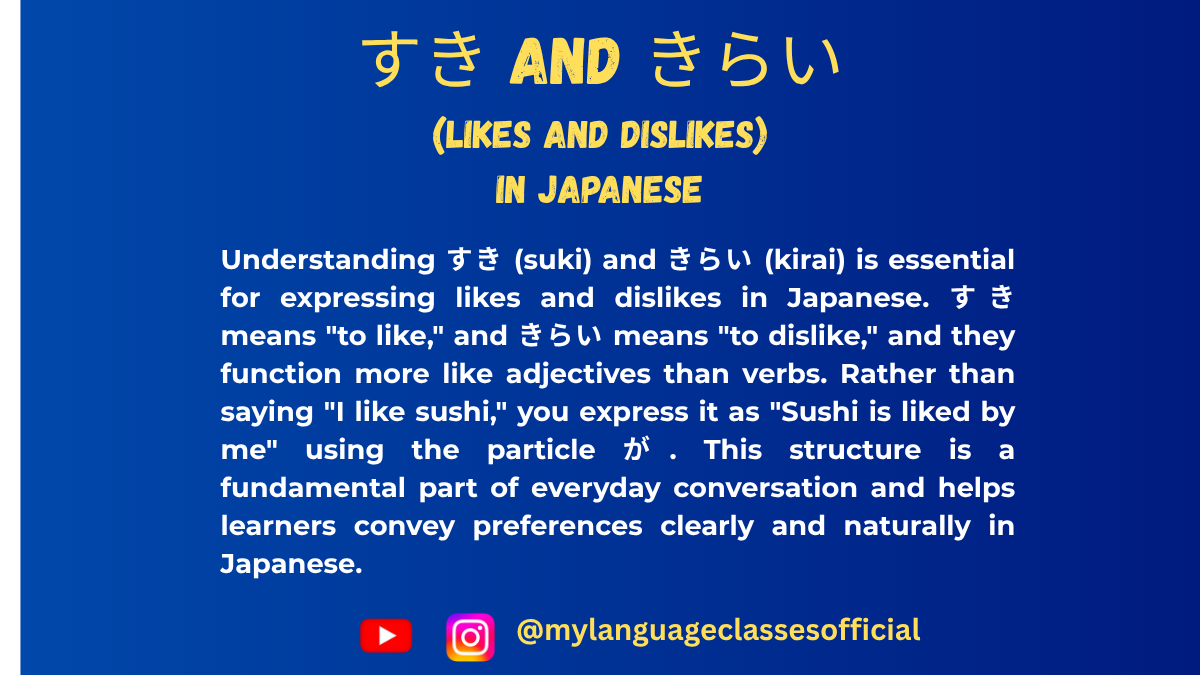
Expressing Likes and Dislikes すき and きらい in Japanese | My Language Classes
Likes and Dislikes in Japanese
こんにちは!(Konnichiwa!)
Learning how to express preferences is one of the most useful and fun parts of mastering Japanese. Today, let’s dive into two essential words: 好き (すき) for “like” and 嫌い (きらい) for “dislike.” Not only will we explore their meanings, but also how to use them naturally in sentences.
1. 好き (すき) – To Like
How to Use 好き
The word 好き means “like” or “fond of” and is commonly used to express your preferences. The structure is simple:
Noun + が好き
This translates to “I like [noun].”Examples:
- 日本語が好きです。
Nihongo ga suki desu.
I like Japanese.- Here, 日本語 (Nihongo) means “Japanese,” and が marks it as the topic you like. Adding です makes it polite.
- 犬が好き。
Inu ga suki.
I like dogs.- This informal version is common among friends or in casual settings.
Expressing Love or Passionate Likes
To emphasize your love or deep passion for something, you can use 大好き (だいすき/daisuki):
- チョコレートが大好きです!
Chokorēto ga daisuki desu!
I love chocolate!
2. 嫌い (きらい) – To Dislike
How to Use 嫌い
On the flip side, 嫌い means “dislike” or “hate.” The structure is the same as 好き:
Noun + が嫌い
This means “I dislike [noun].”Examples:
- ピザが嫌いです。
Piza ga kirai desu.
I dislike pizza.- ピザ (Piza) means “pizza.” While it’s a popular dish, some people might find it too greasy!
- 虫が嫌い。
Mushi ga kirai.
I hate insects.- 虫 (Mushi) refers to “insects.” Use this informal structure with friends.
Expressing Strong Dislike
If you strongly dislike something, you can say 大嫌い (だいきらい/daikirai):
- 雨が大嫌いです!
Ame ga daikirai desu!
I hate rain!
3. Cultural Notes
- “Softer Tone for Dislikes”: In Japanese culture, direct expressions of dislike like 嫌い might come off as too strong in some situations. To soften it, you can use phrases like:
- あまり好きじゃない (Amari suki janai) – “I don’t really like [it].”
- ちょっと苦手です (Chotto nigate desu) – “I’m a bit bad with [it].”
- Overuse of 好き: While 好き is positive, saying it too often might sound insincere. Balance your expressions to match the context.
4. Grammar and Nuance Tips
- No Verb Needed:
Both 好き and 嫌い function as な-adjectives, not verbs. This means they don’t need any conjugation or additional verbs to form basic sentences.Example:- Correct: 猫が好きです。 (Neko ga suki desu. – “I like cats.”)
- Incorrect: 猫が好きをです。 (Neko ga suki wo desu. – This is ungrammatical.)
- が (Ga) vs. は (Wa):
Although が is standard for these structures, は can be used for contrast or emphasis:- 犬は好きですが、猫は嫌いです。
Inu wa suki desu ga, neko wa kirai desu.
I like dogs, but I dislike cats.
- 犬は好きですが、猫は嫌いです。
5. Practice Time!
Let’s put what you’ve learned into action. Try completing these sentences:
- 私は ______ が好きです。
(Watashi wa ______ ga suki desu.)- Translate: “I like ______.”
- 友達は ______ が嫌いです。
(Tomodachi wa ______ ga kirai desu.)- Translate: “My friend dislikes ______.”
- ______ は大好きです!
(______ wa daisuki desu!)- Translate: “I love ______!”
6. Wrap-Up
Now you can confidently express what you like and dislike in Japanese! Start practicing by talking about your favorite foods, hobbies, and activities. Try to notice how native speakers use 好き and 嫌い in conversations—it will deepen your understanding.
If you have questions or want to share your sentences, feel free to leave a comment below!
それでは、またね!(Soredewa, matane!)If you enjoyed this lesson, be sure to check out more posts like this on my blog at My Language Classes. Don’t forget to subscribe my YouTube channel and follow me on Instagram for the latest language learning tips and lessons. Leave a comment below to share your thoughts, or ask any questions you have about nouns.
Happy learning! 😊
- 日本語が好きです。
-
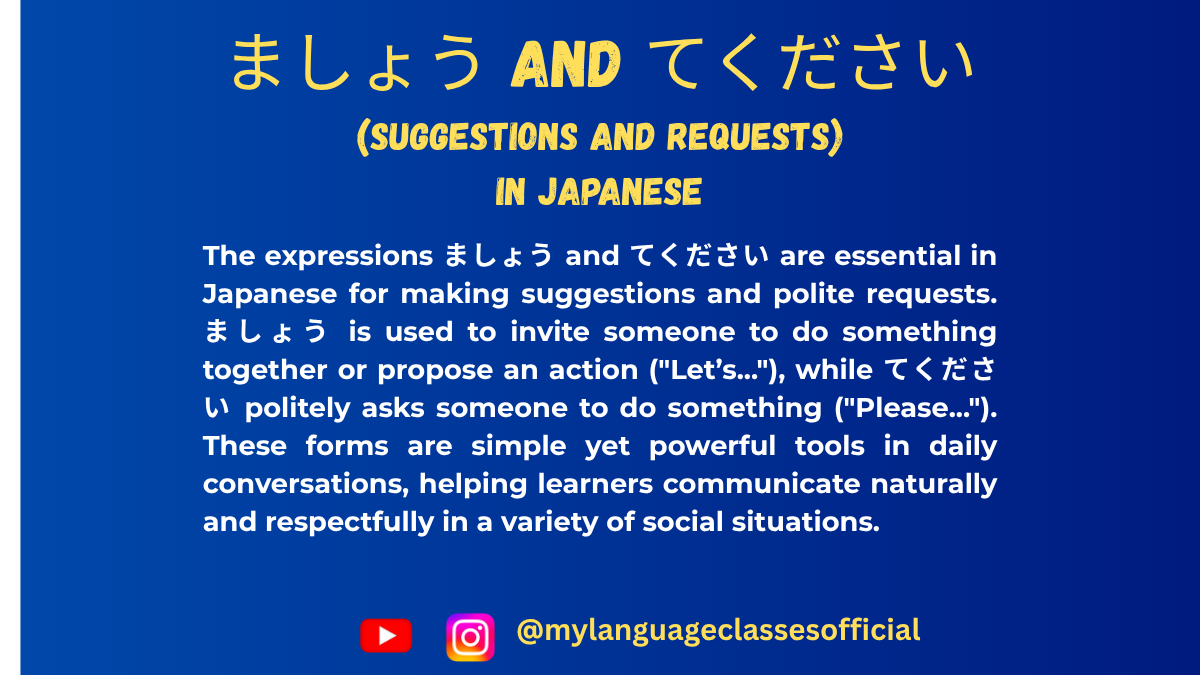
Making Suggestions and Polite Requests ましょう and てください in Japanese | My Language Classes
Mastering Polite Suggestions and Requests in Japanese
If you’re learning Japanese, understanding how to make polite suggestions and requests is a key part of effective communication. Whether you’re planning activities with friends or politely asking for help, two common expressions—Verb stem + ましょう and Verb stem + てください—are your go-to tools. Let’s dive into their usage, including how to form them step by step.
1. Making Suggestions with ましょう (mashou): “Let’s [verb]”
The expression ましょう is a polite and versatile way to suggest an activity or propose an idea. It carries a collaborative tone, meaning “Let’s do [verb].”
How to Form the ましょう Form
Japanese verbs are divided into three groups, and the method for creating the ましょう form depends on the group.
Group 1: U-Verbs (Godan Verbs)
- Start with the stem of the verb (remove the u-ending).
- Replace the u sound with the i sound.
- Add ましょう.
Verb Stem Change to i Form Add ましょう Example Translation 行く 行 行き 行きましょう Let’s go. 書く 書 書き 書きましょう Let’s write. 話す 話 話し 話しましょう Let’s talk.
Group 2: Ru-Verbs (Ichidan Verbs)
- Remove the final る.
- Add ましょう.
Verb Stem Add ましょう Example Translation 食べる 食べ 食べましょう Let’s eat. 見る 見 見ましょう Let’s look.
Group 3: Irregular Verbs
There are two irregular verbs, and their ましょう forms are as follows:
Verb Change to Stem Add ましょう Example Translation する し しましょう Let’s do it. 来る (kuru) 来 (ki) 来ましょう Let’s come.
When to Use ましょう
- Planning with others:
Example: 公園へ行きましょう!(Kōen e ikimashou!) = Let’s go to the park! - Encouraging teamwork:
Example: 一緒に勉強しましょう。(Issho ni benkyou shimashou.) = Let’s study together.
The tone is polite, making it suitable for formal and casual settings, as long as it’s a group-oriented activity.
2. Making Requests with てください (tekudasai): “Please [verb]”
Before diving into てください, we need to understand how to form the te-form of verbs. The te-form is one of the most fundamental conjugations in Japanese grammar and is used in various contexts beyond requests, such as making commands, linking actions, and creating the polite request structure てください.
How to Make the Te-Form
Japanese verbs are categorized into three groups, and the rules for forming the te-form differ depending on the group.
Group 1: U-Verbs (Godan Verbs)
For verbs ending in う, つ, る, む, ぶ, ぬ, く, ぐ, す, follow these rules:
- Replace the final u-sound with its corresponding te-form sound:
Ending Te-Form Rule Example う Replace with って 買う (kau) → 買って (katte) = Buy つ Replace with って 立つ (tatsu) → 立って (tatte) = Stand る Replace with って 取る (toru) → 取って (totte) = Take む Replace with んで 読む (yomu) → 読んで (yonde) = Read ぶ Replace with んで 遊ぶ (asobu) → 遊んで (asonde) = Play ぬ Replace with んで 死ぬ (shinu) → 死んで (shinde) = Die く Replace with いて 書く (kaku) → 書いて (kaite) = Write ぐ Replace with いで 泳ぐ (oyogu) → 泳いで (oyoide) = Swim す Replace with して 話す (hanasu) → 話して (hanashite) = Speak
Group 2: Ru-Verbs (Ichidan Verbs)
For verbs ending in る, simply drop る and add て:
- 食べる (taberu) → 食べて (tabete) = Eat.
- 見る (miru) → 見て (mite) = Look.
Group 3: Irregular Verbs
There are only two irregular verbs in Japanese:
- する → して = Do.
Example: 勉強する (benkyou suru) → 勉強して (benkyou shite) = Study. - 来る (kuru) → 来て (kite) = Come.
Forming てください
Once you have the te-form of a verb, simply add ください to make a polite request:
- 見る (miru) → 見て (mite) + ください = 見てください (mite kudasai) = Please look.
- 書く (kaku) → 書いて (kaite) + ください = 書いてください (kaite kudasai) = Please write.
- 手伝う (tetsudau) → 手伝って (tetsudatte) + ください = 手伝ってください (tetsudatte kudasai) = Please help.
When to Use It
- Asking politely:
Example: ちょっと待ってください。(Chotto matte kudasai.) = Please wait a moment. - Giving instructions:
Example: ドアを閉めてください。(Doa o shimete kudasai.) = Please close the door.
This phrase is polite and commonly used in both formal and informal situations.
Key Differences Between ましょう and てください
Expression Purpose Tone Verb stem + ましょう Suggestion: “Let’s do [verb]” Collaborative and inclusive Verb stem + てください Request: “Please do [verb]” Respectful and polite
Quick Practice: Try It Out!
Let’s put these into practice. Can you guess the correct form for each scenario?
- You’re suggesting to a friend: “Let’s watch a movie.”
Hint: The verb is 見る (miru).
Answer: 映画を見ましょう!(Eiga o mimashou!) - You’re asking someone politely: “Please listen to me.”
Hint: The verb is 聞く (kiku).
Answer: 私の話を聞いてください。(Watashi no hanashi o kiite kudasai.)
Conclusion
Mastering ましょう and てください opens up a world of polite and smooth communication in Japanese. By understanding these structures—and learning how to form the te-form and ましょう—you can make suggestions, request actions, and navigate various social situations with confidence. Practice them in your daily conversations, and soon they’ll become second nature!
What are your favorite phrases using ましょう or てください? Share them in the comments below! Or, if you have any questions about Japanese grammar, feel free to ask. Let’s keep learning together—日本語を楽しみましょう!(Nihongo o tanoshimimashou!) 😊
If you enjoyed this lesson, be sure to check out more posts like this on my blog at My Language Classes. Don’t forget to subscribe my YouTube channel and follow me on Instagram for the latest language learning tips and lessons. Leave a comment below to share your thoughts, or ask any questions you have about nouns.
Happy learning! 😊
-
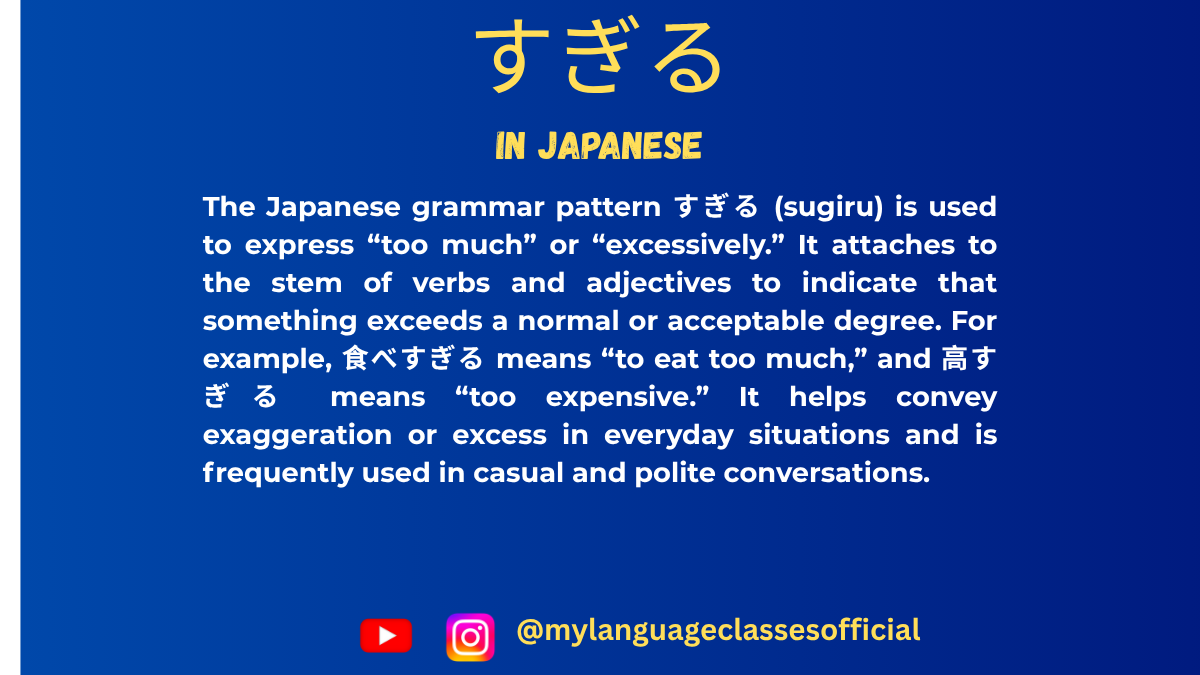
How to Use すぎる in Japanese | My Language Classes
Mastering すぎる: The Key to Expressing Excess in Japanese
When learning Japanese, one of the most versatile tools in your linguistic arsenal is the suffix すぎる (sugiru). This simple yet powerful expression allows you to convey the idea of “too much” or “excessively” with verbs, adjectives, and more. In this blog, we’ll explore how to use it, provide practical examples, and share cultural insights to help you avoid common mistakes.
What Does すぎる Mean?
At its core, すぎる means “to go beyond” or “to exceed.” When attached to the root of a verb or adjective, it transforms the phrase to mean “too much” or “overly.”
For example:- 食べすぎる (tabesugiru): to eat too much.
- 高すぎる (takasugiru): too expensive.
- 使いすぎる (tsukaisugiru): to use too much.
This construction works seamlessly in a wide variety of situations, making it an essential element of everyday conversation.
How to Use すぎる with Verbs
To use すぎる with a verb, follow these steps:
- Take the stem form of the verb (the verb without its final ます in polite form or る in dictionary form).
- Attach すぎる directly to the stem.
Here are some examples:
- 食べる (taberu) → 食べすぎる (tabesugiru): to eat too much.
- 飲む (nomu) → 飲みすぎる (nomisugiru): to drink too much.
- 使う (tsukau) → 使いすぎる (tsukaisugiru): to use too much.
Example sentences:
- 昨日、ラーメンを食べすぎてお腹が痛い。
(Kinō, rāmen o tabesugite onaka ga itai.)
Yesterday, I ate too much ramen, and now my stomach hurts. - 飲み会でお酒を飲みすぎないように気をつけてください。
(Nomikai de osake o nomisuginai yō ni ki o tsukete kudasai.)
Please be careful not to drink too much at the party.
How to Use すぎる with Adjectives
For adjectives, the method depends on whether you’re dealing with an い-adjective or a な-adjective:
1. い-Adjectives
Remove the final い, then add すぎる.
- 高い (takai) → 高すぎる (takasugiru): too expensive.
- 暑い (atsui) → 暑すぎる (atsusugiru): too hot.
Example sentence:
- この服は高すぎて買えない。
(Kono fuku wa takasugite kaenai.)
This clothing is too expensive to buy.
2. な-Adjectives
Simply add すぎる to the base form of the adjective.
- 簡単な (kantanna) → 簡単すぎる (kantansugiru): too simple.
- 静かな (shizukana) → 静かすぎる (shizukasugiru): too quiet.
Example sentence:
- 試験が簡単すぎてびっくりしました。
(Shiken ga kantansugite bikkuri shimashita.)
The test was too easy, and I was surprised.
Nuances and Cultural Tips
- Politeness Matters
In Japanese culture, expressing something as “too much” can sometimes feel blunt. To soften your tone, consider adding phrases like ちょっと (chotto) or using a more indirect expression:
- このラーメン、ちょっと辛すぎると思います。
(Kono rāmen, chotto karasugiru to omoimasu.)
I think this ramen is a little too spicy.
- Avoid Overusing It!
While すぎる is incredibly useful, overusing it can make your speech sound overly critical or negative. Balance it with positive expressions to maintain politeness and harmony in conversations. - Watch for Literal vs. Figurative Use
Sometimes, すぎる is used figuratively:
- 考えすぎる (kangaesugiru): to overthink.
- 頑張りすぎる (ganbarisugiru): to try too hard.
These can reflect emotional or mental states rather than physical actions.
Practice Makes Perfect
To truly master すぎる, try creating your own sentences! Use these prompts:
- What’s something you’ve done “too much” recently?
(食べすぎる, 寝すぎる, 遊びすぎる) - Describe something that felt excessive or overwhelming.
(高すぎる, 静かすぎる, 複雑すぎる)
Conclusion
The すぎる construction is indispensable for describing excess in Japanese. Whether you’re eating too much, overthinking, or facing something outrageously expensive, すぎる lets you express it all with precision and nuance.
So, next time you’re practicing Japanese, try experimenting with すぎる. Not only will it enhance your vocabulary, but it will also deepen your understanding of Japanese culture and conversational dynamics.
Happy learning, and don’t study すぎる (sugiru) much! 😊
If you enjoyed this lesson, be sure to check out more posts like this on my blog at My Language Classes. Don’t forget to subscribe my YouTube channel and follow me on Instagram for the latest language learning tips and lessons. Leave a comment below to share your thoughts, or ask any questions you have about nouns.
Happy learning! 😊
-

Mastering the Te-Form in Japanese | My Language Classes
Mastering the Japanese Te-Form: A Comprehensive Guide
If you’re learning Japanese, one of the most versatile and essential verb forms to master is the te-form. It’s a grammatical powerhouse, allowing you to connect actions, form requests, give commands, and even construct progressive and perfect tenses. Today, let’s dive deep into understanding what the te-form is, why it’s important, and, most importantly, how to form it for all three groups of Japanese verbs.
What Is the Te-Form?
The te-form is a conjugated form of Japanese verbs that ends in て (te) or で (de). It’s named after the final syllable that appears in its conjugation.
Here are the main uses of the te-form:
- Connecting Actions: Link multiple actions in a sentence (e.g., “I woke up, brushed my teeth, and ate breakfast”).
- 朝起きて、歯を磨いて、朝ごはんを食べました。
- Asa okite, ha wo migaite, asagohan wo tabemashita.
- Forming Requests: Politely ask someone to do something.
- ドアを開けてください。
- Doa wo akete kudasai. (Please open the door.)
- Progressive Form: Indicate an ongoing action.
- 今、勉強しています。
- Ima, benkyou shiteimasu. (I’m studying now.)
- Giving Permission or Prohibitions: Say what’s okay or not okay to do.
- 写真を撮ってもいいですか。
- Shashin wo totte mo ii desu ka. (Is it okay to take photos?)
How to Form the Te-Form
To create the te-form, Japanese verbs are categorized into three groups: Group 1 (U-verbs), Group 2 (Ru-verbs), and Group 3 (Irregular verbs). Let’s break down the rules for each group.
Group 1 Verbs (U-Verbs)
Group 1 verbs are the most diverse group. They end in a u sound, such as う, く, す, つ, む, ぶ, ぬ, ぐ, or る (but NOT the same as Group 2 ru-verbs).
Here’s the rule for conjugating these verbs into the te-form:
- Identify the final hiragana of the verb.
- Replace it with its corresponding te/de ending:
Ending in… Change to… Example Te-form う, つ, る って 会う (au, meet) 会って (atte) む, ぶ, ぬ んで 飲む (nomu, drink) 飲んで (nonde) く いて 書く (kaku, write) 書いて (kaite) ぐ いで 泳ぐ (oyogu, swim) 泳いで (oyoide) す して 話す (hanasu, speak) 話して (hanashite)
Group 2 Verbs (Ru-Verbs)
Group 2 verbs are simpler to handle. They end in る, and their stems typically have an i or e vowel sound before る (e.g., 食べる, 見る).
To form the te-form:
- Remove the final る.
- Add て.
Example Verb Te-form 食べる (taberu, eat) 食べて (tabete) 見る (miru, see) 見て (mite)
Group 3 Verbs (Irregular Verbs)
There are only two main irregular verbs, and their te-forms must be memorized.
Verb Te-form する (suru, do) して (shite) 来る (kuru, come) 来て (kite) Another commonly used irregular verb is 行く (iku, go), which is a Group 1 verb but has an exceptional te-form:
- 行く (iku, go) → 行って (itte).
Practice Makes Perfect!
Here’s a quick exercise to check your understanding. Convert the following verbs to their te-forms:
- 飲む (nomu, drink) → __________
- 書く (kaku, write) → __________
- 食べる (taberu, eat) → __________
- 来る (kuru, come) → __________
- 話す (hanasu, speak) → __________
Tips for Remembering the Te-Form
- Group 1 Mnemonic: Think of “tsu, ru, u” as “tte” and “mu, bu, nu” as “nde.” Sing these patterns like a rhythm to memorize them!
- Practice in Context: Use real-life examples to internalize the rules. For example, narrate your daily routine in Japanese using the te-form.
By mastering the te-form, you unlock the ability to express yourself in so many more ways in Japanese. It’s a gateway to conversational fluency and one of the most rewarding aspects of learning the language. So, practice regularly, and soon it’ll feel as natural as saying “ありがとう!”
Got any questions or examples of your own? Share them in the comments!
If you enjoyed this lesson, be sure to check out more posts like this on my blog at My Language Classes. Don’t forget to subscribe my YouTube channel and follow me on Instagram for the latest language learning tips and lessons. Leave a comment below to share your thoughts, or ask any questions you have about nouns.
Happy learning! 😊
- Connecting Actions: Link multiple actions in a sentence (e.g., “I woke up, brushed my teeth, and ate breakfast”).

